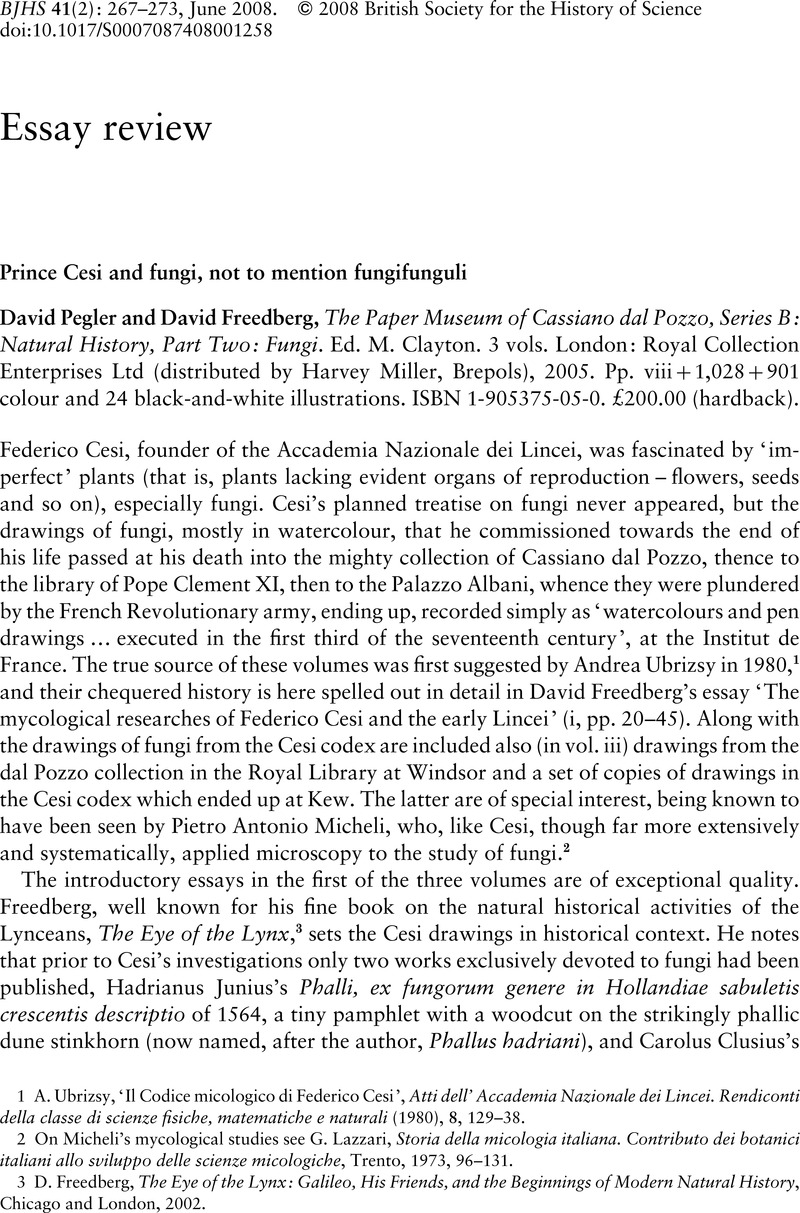Article contents
Prince Cesi and fungi, not to mention fungifunguli
Published online by Cambridge University Press: 16 June 2008
Abstract

- Type
- Essay Review
- Information
- Copyright
- Copyright © 2008 British Society for the History of Science
References
1 A. Ubrizsy, ‘Il Codice micologico di Federico Cesi’, Atti dell' Accademia Nazionale dei Lincei. Rendiconti della classe di scienze fisiche, matematiche e naturali (1980), 8, 129–38.
2 On Micheli's mycological studies see G. Lazzari, Storia della micologia italiana. Contributo dei botanici italiani allo sviluppo delle scienze micologiche, Trento, 1973, 96–131.
3 D. Freedberg, The Eye of the Lynx: Galileo, His Friends, and the Beginnings of Modern Natural History, Chicago and London, 2002.
4 On the complex publication history of the Tesoro Messicano and Tabulae phytosophicae see Freedberg, op. cit. (3), Chapter 9.
5 F. Cesi, Phytosophicarum tabularum ex frontispiciis naturalis theatri …, in F. Hernández, Nova plantarum, animalium et mineralium Mexicanorum historia, Rome, 1651, 901–52.
6 In this connection Freedberg mentions the dialectical division ‘perfected by Ramus and his followers’. However, unlike them Cesi does not confine himself to dichotomies, and includes quite substantial disquisitions under the various headings and in associated typographical boxes. There was a substantial tradition, dating from well before Ramus, of such more flexible polychotomous Tabulae and Tabellae in printed medical and natural-historical books: see K. J. Höltgen, ‘Synoptische Tabellen in der medizinischen Literatur und die Logik Agricolas und Ramus’, Sudhoffs Archiv (1965), 49, 371–90; S. Ferguson, ‘System and schema: tabulae of the fifteenth to eighteenth centuries’, Princeton University Library Chronicle (1987), 49, 9–30; and I. Maclean, ‘Logical division and visual dichotomies: Ramus in the context of legal and medical writing’, in The Influence of Petrus Ramus (ed. M. Feingold, J. S. Freedman and W. Rother), Basel, 2001, 228–47.
7 On Aristotle's use of division in the pursuit of definitions of parts and functions see P. Pellegrin, Aristotle's Classification of Animals: Biology and the Conceptual Unity of the Aristotelian Corpus, revised ed., trans. A. Preus, Berkeley, CA, 1986 (first published 1982); D. M. Balme, ‘Aristotle's use of division and differentiae’, in Philosophical Issues in Aristotle's Biology (ed. A. Gotthelf and J. G. Lennox), Cambridge, 1987, 69–89. The importance of these authoritative accounts is noted by Freedberg: i, 43, n. 4.
8 Pellegrin, op. cit. (7); Balme, op. cit. (7); S. Atran, Cognitive Foundations of Natural History: Towards an Anthropology of Science, Cambridge, 1990. Long ago George Henry Lewes declared that ‘it is only by bringing together certain general statements, and disregarding the whole context, that a plausible scheme can be drawn up from his works; and so far from his having laid ‘the eternal bases’ upon which moderns have erected their classification, it does not appear that he had ever attempted a special arrangement of the various groups of animals'. G. H. Lewes, Aristotle: A Chapter from the History of Science, London, 1864, 273; added emphases (a passage pointed out to me by Andrew Cunningham).
9 Atran, op. cit. (8). See also B. Berlin, D. Breedlove and P. Raven, ‘General principles of classification and a nomenclature in folk biology’, American Anthropologist (1973), 75, 214–42, and other articles by these authors cited in Atran.
10 See, for example, the articles in R. F. Ellen and D. Reason (eds.), Classifications in Their Social Context, London, New York and San Francisco, 1979; also E. S. Hunn, ‘The utilitarian factor in folk biological classification’, American Anthropologist (1982), 84, 830–47.
11 On canonical living beings see E. R. Anderson, Folk Taxonomies in Early English, Madison and Teaneck, 2003, Chapter 12, ‘Taxonomies and the problem of universals’.
- 1
- Cited by


